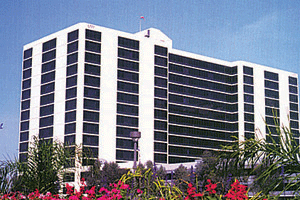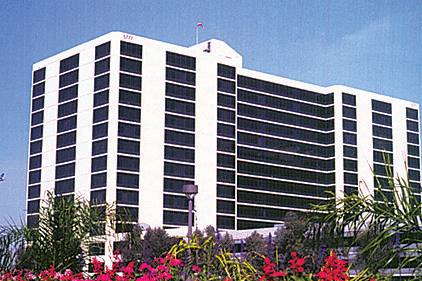“Too warm.”

|
| UVC light emitters installed downstream of the cooling coil increased airflow in this university building by 30%. |
“Too stuffy.”
“Not enough airflow.”
These were just a few of the countless complaints that facilities managers of the Basic Medical Science Building at the University of New Mexico were receiving on a regular basis. The poor performance of their 40-yr-old HVAC system often resulted in lectures being moved outside or cancelled altogether. And the situation in lecture halls and research rooms serviced by Fan 67 had become particularly dire. The coil in that fan was completely clogged. According to Elmo Riggs, facilities supervisor, “You couldn’t see through it, or hear through it at all.”
PRICEY UPGRADES NEEDED
Replacing the coils in all five fans serving the building would cost $500,000, according to Fred Best, manager of maintenance and planning. And that was just the cost of the installation. When the amount of downtime and the disruption the building’s occupants were taken into account, the cost of replacement coils soars even higher. But Kevin Givens of The Johnston Company, specializing in HVAC systems, offered a simple and much less expensive solution. Givens suggested the university install Steril-Aire UVC light emitters on the downstream of Fan 67’s cooling coil to clean the coil of its sticky, gunky biofilm buildup.
While many of the facilities managers were skeptical that this could even remotely improve the situation, they gave Givens the go ahead. If the UVC worked, they would then install them on the remaining five fans.
A third-party, certified TAB company was hired to perform baseline air-handler tests including measuring airflow, air/water temperature, and static pressure (sp) drop.
BREATHING ROOMS
The air quality in every room serviced by Fan 67 improved. Within weeks, complaint calls from professors were down. In fact, facilities managers were getting unsolicited positive feedback regarding the change in air temperature and quality. After 60 days, follow-up tests generated some incredible results: airflow measured 992 cfm, a gain of +14%; a 0.07 in. sp reduction; a net cooling capacity of 300,685 Btuh, for a gain of +208%; and a 78%/50% gain in db/wb separation.
And after 270 days, another follow-up was done and revealed that the airflow was up a whopping 30%.
In addition, university industrial hygienist Terry Anderson performed carbon dioxide measurements in a room served by Fan 67. In the corner of the room furthest from the ductwork, the ach had doubled even though the occupancy had also doubled. Riggs has his own spin on how well the UVC worked. “You can carry on a good conversation through the coil in Fan 67 now,” he said. In fact, not long after the results of the experiment were known, the remaining five fans in the building were outfitted with Steril-Aire UVC.
ENERGY SAVINGS OF NEARLY $210,000
Not only did Steril-Aire help make the building livable, it also saved the university approximately $500,000 in coil replacement costs. Furthermore, it is estimated the move will save the school approximately $209,030 in energy costs over the next four years.


